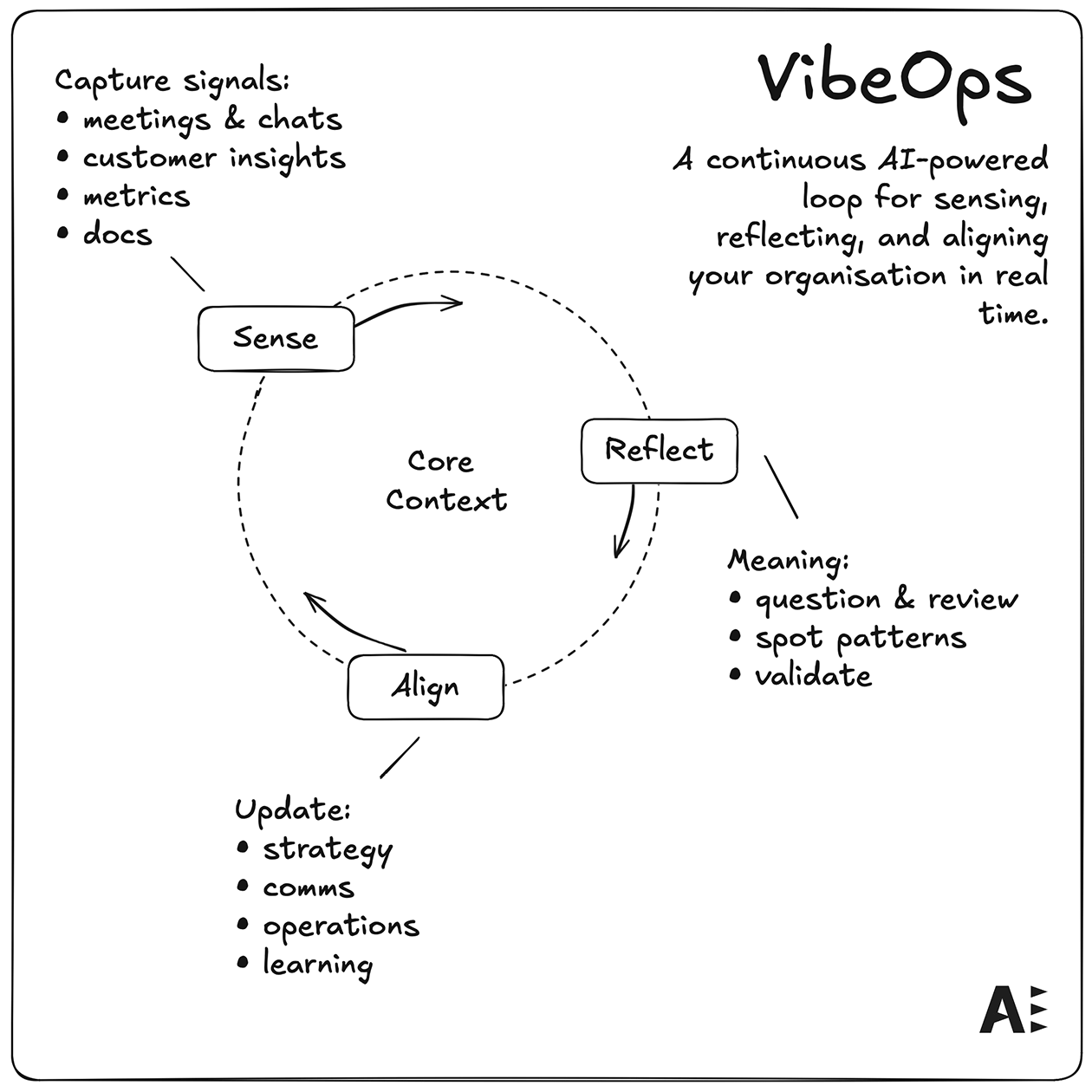VibeOps - The Emerging AI-First Operating Model?
Nov 09, 2025
VibeOps - What Happens When a True Intelligence Layer Becomes Real
For years, businesses have dreamed of having a living intelligence layer, something that can see everything happening across the organisation.
Every meeting, every customer conversation, every performance metric, every idea.
A connected system that not only stores information, but understands it, reflects on it, and helps people act faster and more intelligently.
That vision has always been out of reach, until now.
With tools like Notion, Slack, and other connected systems now embedding AI directly into their core, this long-standing aspiration is finally becoming viable (like in the last couple of months).
For the first time, AI can actually see across your organisation. It can read your documents, listen to your meetings, understand your metrics, and link context between every part of your business.
And when that happens, the way you run a company changes completely.
Introducing VibeOps
At AI Accelerator, we’re calling this new way of working VibeOps, the operating rhythm of AI-first organisations.
VibeOps is what happens when your company starts to think with itself.
It’s a continuous loop of sensing, reflecting, and aligning, powered by an intelligence layer that’s always learning from your own conversations, insights, and decisions.
Instead of rigid meetings and periodic strategy reviews, the business develops a real-time pulse.
People talk to AI, AI reflects back patterns, and the company learns through conversation.
Key Insights from Our Work
Through our own experience of running AI Accelerator this way, and supporting clients making the same transition, here’s what we’ve discovered about what happens when a true intelligence layer becomes real:
1. Recording every conversation changes everything
Once AI has access to your calls, meetings, and communications, both internal and external, your company's memory becomes (nearly) perfect.
It remembers what was said, who said it, and how decisions evolved.
This level of capture creates new accountability but also new insight.
You start spotting patterns you could never see before, recurring issues, missing connections, repeating questions.
The challenge becomes less about remembering and more about making sense of what's already known.
2. Build systems from an AI-first perspective
Most businesses are still designing their systems for humans, and then adding AI on top.
But the shift to VibeOps means reversing that logic: build your organisation so that AI can do its best work.
That means:
- Making information accessible, structured, and linked.
- Writing and documenting for AI comprehension, not just for humans.
- Ensuring every system (CRM, calendars, Notion, email, Slack, analytics) can connect contextually.
If AI can’t access the right information easily, it can’t help you reflect intelligently.
3. Standardising around how AI works takes time
When you start building an AI-first organisation, you quickly realise that consistency matters more than sophistication.
Standardising naming, formatting, tagging, and data handling sounds dull, but it’s the difference between an AI that’s insightful and one that’s confused.
A good rule of thumb: the simpler and more structured your inputs, the smarter your AI output becomes.
4. Working with AI requires new behaviours
Working in this new way doesn't actually come naturally. It takes a bit of time to learn how to think with it.
Things we are finding include:
- Let AI prompt you. Getting AI to ask you questions is the best way to optimise interactions. Harness the cognitive power, but lead it towards your goal.
- Reflect regularly through dialogue, not just documentation.
AI becomes part mirror, part mentor, but only if you treat it as a thinking partner rather than a machine.
5. Trust and accuracy must be balanced
One of the biggest challenges in VibeOps is the trust trade-off.
AI can move fast, but it can also confidently overwrite your work if you’re not careful.
We’ve learned that the key is to interrogate before implementation.
Always ask the AI to check or critique its ideas before acting on them. "What assumptions have you made?" or "What would you change if this context were different?"
That keeps AI in a reflective mode, not a destructive one.
Get ready for the world of ‘Agentic Organisations’ to learn this the hard way.
6. Discernment becomes the ultimate leadership skill
As AI starts producing more (content, analysis, insights), the volume of information grows exponentially.
Not all of it is good.
In fact, some of it’s AI slop.
VibeOps demands a high level of discernment: the ability to spot what’s truly valuable and filter out what isn’t.
This requires critical thinking and awareness of the tendency for AI to be a sycophant.
The Shift Ahead
The arrival of a true intelligence layer marks a turning point in how companies operate. It's still early days, and we are learning the hard way what works and what doesn't, but the glimpses of capability we are spotting are astounding.
VibeOps represents that shift: from command-and-control management to a cycle of continuous reflection and adaptation.
From documentation to dialogue.
From systems that store knowledge to systems that understand it.
This is the rhythm of the AI-first organisation.
And once you feel it, you don’t go back.
Do you want to learn more about AI and how you can leverage it right now? Join the AI revolution by taking our AI Accelerator today.
Get your AI edge
Join the Artificial Intelligence revolution now by subscribing to our newsletter. Access the latest insight, tools, techniques and use cases for AI to give you an edge.
We hate SPAM. We will never sell your information, for any reason.


